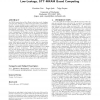Free Online Productivity Tools
i2Speak
i2Symbol
i2OCR
iTex2Img
iWeb2Print
iWeb2Shot
i2Type
iPdf2Split
iPdf2Merge
i2Bopomofo
i2Arabic
i2Style
i2Image
i2PDF
iLatex2Rtf
Sci2ools
ISCA
2010
IEEE
2010
IEEE
Resistive computation: avoiding the power wall with low-leakage, STT-MRAM based computing
As CMOS scales beyond the 45nm technology node, leakage concerns are starting to limit microprocessor performance growth. To keep dynamic power constant across process generations, traditional MOSFET scaling theory prescribes reducing supply and threshold voltages in proportion to device dimensions, a practice that induces an exponential increase in subthreshold leakage. As a result, leakage power has become comparable to dynamic power in current-generation processes, and will soon exceed it in magnitude if voltages are scaled down any further. Beyond this inflection point, multicore processors will not be able to afford keeping more than a small fraction of all cores active at any given moment. Multicore scaling will soon hit a power wall. This paper presents resistive computation, a new technique that aims at avoiding the power wall by migrating most of the functionality of a modern microprocessor from CMOS to spin-torque transfer magnetoresistive RAM (STTMRAM)—a CMOS-compatible...
| Added | 10 Jul 2010 |
| Updated | 10 Jul 2010 |
| Type | Conference |
| Year | 2010 |
| Where | ISCA |
| Authors | Xiaochen Guo, Engin Ipek, Tolga Soyata |
Comments (0)

